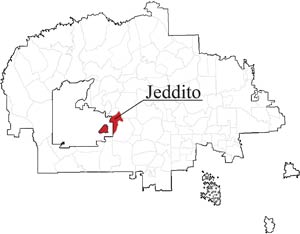The island chapter
Jeddito is surrounded by Hopi land
By Cindy Yurth
Tséyi' Bureau
JEDDITO, Ariz., May 30, 2013
(Editor's note: In an effort to chronicle the beauty and diversity of the Navajo Nation, as well as its issues, the Navajo Times has committed to visiting all 110 chapters in alphabetical order. This is the 37th in the series.)

S itting in the Jeddito Chapter House, it's not readily apparent you're on an island. Until you ask someone what time it is.
Here at the chapter house, it's 11 a.m. but across the streets at the elementary school, it's 10.
Since the partitioning of the Joint Use area in the 1970s, part of this tiny chapter -- which now comprises less than five square miles -- is completely surrounded by Hopi land.
Since the Hopis follow the rest of Arizona's lead and don't observe daylight savings time, and quite a few Hopis attend school here, the school runs on Mountain Standard Time year around.
"I send my kids to school on Mountain time," said Accounts Maintenance Specialist Emerita Baker, "and I go to work on Daylight time."
Why doesn't the rest of the chapter just go with the flow?
"Because," said Baker a bit defiantly, "we're on the Navajo Nation."
The president of this unique if problematic chapter doesn't want to reveal his age, lest he give credence to his critics who think he's too young to hold this office. Suffice it to say Terry Yazzie still wears braces.
One thing you cannot accuse Yazzie of, however, is ignorance of his chapter. He wrote his master's thesis on its now defunct trading post, and there's hardly a question you can ask him about Jeddito (which translates to "Antelope Springs" in English) that he can't answer.
Nevertheless, he's not quite sure how this part of the chapter came to be an island.
"My best guess," he said, "is that there was too big a concentration of Navajos living around the spring area, and the government didn't want to move them all."
Yazzie is not too young to remember the partition fence going up in the mid-70s, and families holding their breath that they would be on the "right" side, the Navajo side.
"There were some extended families that were split," Yazzie recalled. "Some of their members had to move to Sanders and some got to stay."
Today, being surrounded by another tribal jurisdiction makes the chapter a headache to manage.
"We have to go through extreme hoops to get anything done," Yazzie sighed.
The chapter is discovering some ways around flailing through the red tape of two tribal bureaucracies; a recent water line was built along State Highway 264, which meant it only had to negotiate with the state of Arizona.
While a lot of Jeddito residents are still without running water, electric power has been brought to all but the most scattered homesites. Cellular service is good as long as you have Cellular One.
With no businesses and even the nearest convenience store a few miles away in Keams Canyon, Jeddito suffers from unemployment even more than the rest of the Navajo Nation. Yazzie estimates fewer than half its citizens are employed, and unless you're lucky enough to get a job at the lone public school, you have a long commute.
Yazzie himself works 63 miles away at the Diné College branch in Window Rock, where he teaches adult basic education.
Both Winslow and Holbrook are an hour-and-a-half away by car; Gallup is a little farther.
"A lot of people applied for jobs at the new (Twin Arrows) casino," said Baker, even though it's close to two hours away.
The school, which peaked in the late 1990s with 800 students, was once a significant employer, but since the Indian Wells school opened in 2001 and the Hopis improved their school system, Jeddito's enrollment has dwindled to about 200.
Yazzie's big dream for the chapter is a store and gas station on 264 - a project for which previous administrations laid the groundwork -- "but with the sequester, everything's on hold."
He'd also like to develop some sort of recreation for the chapter youth, which he believes will help curtail the graffiti and vandalism that has recently beset the chapter. With the nearest Navajo police station all the way in Dilkon, and not much legal recreation available, "the youth do what they do," he said.
A lot of the chapter's more promising young people flee for the city the minute they graduate, and with his master's degree and soon-to-be perfect teeth, Yazzie could easily have joined them. But the bright lights of Flagstaff or Albuquerque hold no appeal for this island boy.
On his lunch break from his teaching job in Window Rock, he reflects on why.
"All my relations are there," he said of Jeddito. "That's where I feel the spiritual side of me being really free."
Jeddito at a Glance
Name - A corruption of Jadi To, "Antelope Springs," for a water source that attracted pronghorn. According to Chapter President Terry Yazzie, you can still occasionally see the elusive animals, "mostly in winter."
History - Navajos have lived near the spring since the 1700s.
Population - about 1,200
Land area - five square miles, divided between the "big Rez" and "Jeddito Island," a circle of Navajo land surrounded by the Hopi reservation.
Major Clans - Edgewater, Tachiinii, Towering House, Tl'izilani, Tabaaha, To'dich'iinii. There is some intermarriage with the neighboring Hopi, but "not as much as you would probably think," according to Yazzie.
Assets - beautiful setting amid forested cliffs, Highway 264 frontage
Problems - graffiti, severe unemployment, isolation

